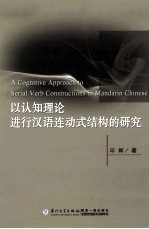

以认知理论进行汉语连动式结构的研究 英文版PDF电子书下载
- 电子书积分:9 积分如何计算积分?
- 作 者:印辉著
- 出 版 社:厦门:厦门大学出版社
- 出版年份:2012
- ISBN:9787561545270
- 页数:179 页
Chapter 1 Introduction 1
Chapter 2 Past Treatments of Serial Verb Constructions 4
2.1 Past Approaches to SVCs 4
2.1.1 Christaller(1875) 4
2.1.2 Westermann(1930) 6
2.1.3 Stewart(1963) 7
2.1.4 Bamgbose(1974) 9
2.1.5 Baker(1989) 11
2.1.6 Agbedor(1994) 13
2.1.7 Aikhenvald(2006) 17
2.2 Past Approaches to Chinese SVCs 21
2.2.1 Chao(1968) 21
2.2.2 Li and Thompson(1981) 23
2.2.3 Dai(1990) 24
2.2.4 Paul(2004) 27
2.3 Discussion 31
Chapter 3 Basic Tenets of Cognitive Grammar 32
3.1 Assumptions of Cognitive Grammar 32
3.2 Symbolization 34
3.3 Construction and Composition 36
3.4 Base vs.Profile 38
3.5 Construal 39
3.6 Perspective 40
3 7 Action Chain 42
3.8 Lexicon and Syntax 42
3.9 Schematic Representation of a Transitive Event 44
Chapter 4 The Present Analysis 45
4.1 Three Iconically Based Semantic Principles 45
4.1.1 Principle of Temporal Sequence and Scope 46
4.1.2 Principle of Shared Participants 48
4.1.3 Principle of Situational Dependence 48
4.2 Conceptual Event 49
4.3 Laying Out the Event Conflation Continuum 53
4.4 Event Structure of Coordination,Subordination,and SVCs 54
4.5 Morphosyntactic and Prosodic Tests of Event Conflation 57
Chapter 5 The Five Constructions and the Seven Tests 62
5.1 Coordinate Constructions 62
5.1.1 Schematic Representation 62
5.1.2 Application of Tests 63
5.1.3 Discussion 64
5.2 Complement Constructions 65
5.2.1 Schematic Representation 65
5.2.2 Application of Tests 68
5.2.3 Discussion 70
5.3 Purposive Constructions 70
5.3.1 Purposive Complements or Separate Clauses 70
5.3.2 The Three Principles Reflected in Purposive SVCs 72
5.3.3 Schematic Representation 75
5.3.4 Application of the Tests 75
5.3.5 Discussion 77
5.4 Double-headed or Shared Object Constructions 78
5.4.1 The Three Principles Reflected in Double-headed Constructions 79
5.4.2 Schematic Representation 80
5.4.3 Application of Tests 82
5.4.4 Discussion 83
5.5 The So-called VV Compounds—A Continuum Between Lexicon and syntax 84
5.5.1 Parallel VV Compounds 84
5.5.2 Phase VV Compounds 85
5.5.3 Resultative VV Compounds 87
5.5.4 Directional VV Compounds 89
5.6 VV Compounds as SVCs 93
5.6.1 SVCs with Complements of Result 94
5.6.2 SVCs with Complements of Direction 99
5.6.3 Schematic Representation 104
5.6.4 Application of Tests 104
5.7 Discussion 106
Chapter 6 Coverb Constructions 111
6.1 Traditional Criteria 112
6.2 Problematic Criteria 112
6.3 Verbhood Tests 115
6 4 Present Analysis 116
6.4.1 Coverbs—A Continuum 116
6.4.2 Entities Undergoing Process 118
6.5 Metaphorical and Functional Extensions 118
6.5.1 Na'take'—Instrumental and Topic Marker 119
6.5.2 Ba—Object Marker 120
6.5.3 Gei(give)—Recipient Marker and Benefactive Use 120
6.6 Differences between SVCs and CoVCs 121
Chapter 7 Psycholinguistic Experiments 124
7.1 Experiment One 124
7.2 Experiment Two 126
Chapter 8 The Association of Multi-Verb Constructions with Verbs 128
8.1 Coordinate Construction 129
8.2 Complement Construction 132
8.3 Purposive Construction 139
8.4 Shared Object Construction 145
8.5 Compound Construction 147
8.5.1 Contiguous Compounds Containing Lai'Come'and Qu'Go' 150
8.5.2 Contiguous Compounds Containing Motion Verbs other than Lai and Qu 157
Chapter 9 Conclusions 161
Bibliography 164
- 《SQL与关系数据库理论》(美)戴特(C.J.Date) 2019
- 《联吡啶基钌光敏染料的结构与性能的理论研究》李明霞 2019
- 《异质性条件下技术创新最优市场结构研究 以中国高技术产业为例》千慧雄 2019
- 《法语词汇认知联想记忆法》刘莲编著 2020
- 《情报学 服务国家安全与发展的现代情报理论》赵冰峰著 2018
- 《英汉翻译理论的多维阐释及应用剖析》常瑞娟著 2019
- 《新课标背景下英语教学理论与教学活动研究》应丽君 2018
- 《党员干部理论学习培训教材 理论热点问题党员干部学习辅导》(中国)胡磊 2018
- 《虚拟流域环境理论技术研究与应用》冶运涛蒋云钟梁犁丽曹引等编著 2019
- 《卓有成效的管理者 中英文双语版》(美)彼得·德鲁克许是祥译;那国毅审校 2019
- 《人生幸福密码 精装版》陈进辉著 2017
- 《厉害是攒出来的》刘杰辉著 2019
- 《可持续发展与化工绿色物流研究》何玲辉著 2012
- 《福州话字词笔记》马书辉著 2019
- 《有机光伏材料的模拟、计算与设计》郑绍辉著 2019
- 《《家庭、私有制和国家的起源》张仲实译本考》刘曙辉著 2019
- 《图式法与形而上学奠基》仲辉著 2019
- 《神在人间的时光》陈喜辉著 2019
- 《霍去病》胡辉著 2019
- 《让金融回归本义》毛志辉著 2019
- 《大学计算机实验指导及习题解答》曹成志,宋长龙 2019
- 《大学生心理健康与人生发展》王琳责任编辑;(中国)肖宇 2019
- 《大学英语四级考试全真试题 标准模拟 四级》汪开虎主编 2012
- 《大学英语教学的跨文化交际视角研究与创新发展》许丽云,刘枫,尚利明著 2020
- 《复旦大学新闻学院教授学术丛书 新闻实务随想录》刘海贵 2019
- 《大学英语综合教程 1》王佃春,骆敏主编 2015
- 《大学物理简明教程 下 第2版》施卫主编 2020
- 《大学化学实验》李爱勤,侯学会主编 2016
- 《中国十大出版家》王震,贺越明著 1991
- 《近代民营出版机构的英语函授教育 以“商务、中华、开明”函授学校为个案 1915年-1946年版》丁伟 2017
